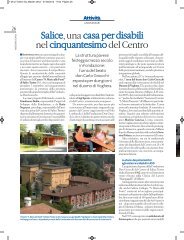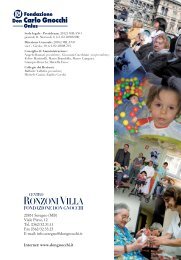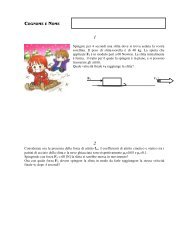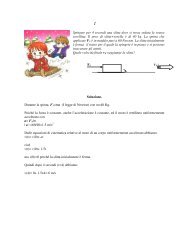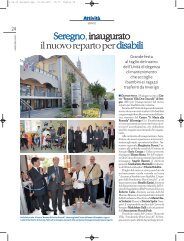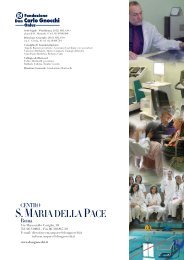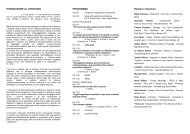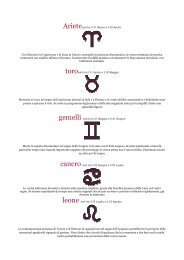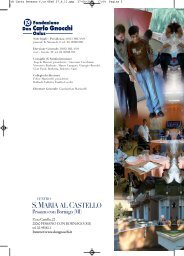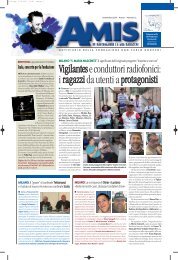Linea di Ricerca 1 - Fondazione Don Carlo Gnocchi
Linea di Ricerca 1 - Fondazione Don Carlo Gnocchi
Linea di Ricerca 1 - Fondazione Don Carlo Gnocchi
Create successful ePaper yourself
Turn your PDF publications into a flip-book with our unique Google optimized e-Paper software.
trattare anche muscoli prossimali (che agiscono su spalla<br />
e gomito) per ottimizzare il trattamento e ampliare la casistica<br />
dei potenziali fruitori del sistema. A questo fine è<br />
iniziato lo sviluppo <strong>di</strong> un sistema MeCFES multicanale la<br />
cui applicazione su pazienti è prevista nel 2011.<br />
2. I risultati ottenuti finora dalla robot-terapia sui pazienti con<br />
SM <strong>di</strong>mostrano che dopo il training, entrambi i gruppi migliorano<br />
significativamente la velocità, la linearità e la flui<strong>di</strong>tà<br />
del movimento <strong>di</strong> reaching. Per quanto riguarda la trasferibilità<br />
degli effetti a compiti funzionali, il gruppo trattato con<br />
training virtuale mostra un moderato miglioramento (ARAT:<br />
+2 pt; 9HPT: 18%) mentre nel gruppo funzionale sembrano<br />
<strong>di</strong>stinguersi 2 sottogruppi: 3 pazienti ottengono un miglioramento<br />
clinicamente significativo (ARAT: +5 pt; 9HPT: 29%),<br />
mentre gli altri 3 pazienti non presentano alcun effetto consistente<br />
(ARAT: −0,3 pt; 9HPT: −15%). Sulla base delle evidenze<br />
finora raccolte si può concludere che entrambi gli<br />
approcci <strong>di</strong> robot-terapia sono applicabili in ambito clinico<br />
e migliorano la coor<strong>di</strong>nazione dell’arto superiore. Mentre il<br />
protocollo virtuale produce moderati miglioramenti anche<br />
in compiti funzionali, il training virtuale sembra essere significativamente<br />
efficace solo nel 50% dei pazienti trattati.<br />
Benché non si possano trarre conclusioni prima della conclusione<br />
del reclutamento, questi risultati preliminari suggeriscono<br />
che in alcuni soggetti gli effetti della terapia robotica<br />
possono essere migliorati aggiungendo ai <strong>di</strong>spositivi<br />
esistenti la possibilità <strong>di</strong> far eseguire compiti più vicini alle<br />
ADL. In futuro occorrerà valutare se esistono in<strong>di</strong>ci che permettano<br />
a priori <strong>di</strong> stabilire se un soggetto potrà beneficiare<br />
<strong>di</strong> protocolli funzionali <strong>di</strong> terapia robotica.<br />
3. I risultati ottenuti sui primi 3 pazienti con esiti <strong>di</strong> ictus, hanno<br />
per ora <strong>di</strong>mostrato la fattibilità <strong>di</strong> raccogliere dati sui miglioramenti<br />
nella funzione locomotoria (valutata tramite gait<br />
analysis) dovuti alla riabilitazione con biofeedback e sulle<br />
corrispondenti mo<strong>di</strong>fiche nell’attivazione cerebrale (rilevata<br />
tramite fMRI) durante l’esecuzione <strong>di</strong> movimenti del piede<br />
(Del Din et al., 2011). La casistica è però ancora troppo limitata<br />
per trarre conclusioni sulla correlazione fra miglioranti<br />
nel cammino e mo<strong>di</strong>fiche nell’attivazione corticale.<br />
<strong>Linea</strong> <strong>di</strong> <strong>Ricerca</strong> 1<br />
PRODOTTI SCIENTIFICI<br />
– Carpinella I, Cattaneo D, Abuarqub S, Ferrarin M. Robot-based<br />
rehabilitation of the upper limbs in multiple sclerosis:<br />
Feasibility and preliminary results. J Rehabil Med. 2009<br />
Nov;41(12):966-70.<br />
– Thorsen R, Cortesi M, Jonsdottir J, Carpinella I, Morelli D,<br />
Casa<strong>di</strong>o M, Puglia M, Mazzoleni P, Casiraghi A, Diverio M,<br />
Converti RM, Ferrarin M. Rehabilitation of the hemiplegic<br />
hand with MeCFES – An interim analysis of the influence<br />
of treatment frequency on the outcome. 14 th Annual Conference<br />
of the International FES Society, September 13 th -<br />
17 th , 2009 – Seoul (Corea), pp. 63-64, 2009.<br />
– Jonsdottir J, Cattaneo D, Recalcati M, Regola A, Rabuffetti<br />
M, Ferrarin M, Casiraghi A. Task-Oriented Biofeedback<br />
to Improve Gait in In<strong>di</strong>viduals With Chronic Stroke: Motor<br />
Learning Approach. Neurorehabil Neural Repair. 2010<br />
Jun;24(5):478-85.<br />
– Thorsen R, Cortesi M, Jonsdottir J, Carpinella I, Morelli D,<br />
Casiraghi A, Converti RM, Ferrarin M. Improving the Hemiplegic<br />
Hand Function by FES using Direct Myoelectric<br />
Control. 15 th Annual International FES Society Conference<br />
and 10 th Vienna Int. Workshop on FES Vienna (Austria),<br />
September 8 th -12 th , 2010.<br />
– Del Din S, Bertoldo A, Sawacha Z, Rabuffetti R, Ferrarin<br />
M, Laganà M, Jonsdottir J, Baglio F, Rovaris M, Cobelli<br />
C. fMRI analysis of brain activation during ankle dorsi/plantarflexion<br />
in post-stroke patients: a case study. II<br />
Congresso Nazionale <strong>di</strong> Bioingegneria, GNB2010, Torino,<br />
8-10 luglio 2010.<br />
– Del Din S, Bertoldo A, Sawacha Z, Rabuffetti M, Laganà<br />
M, Jonsdottir J, Baglio F, Rovaris M, Cobelli C, Ferrarin M.<br />
Combined analysis of fMRI and gait analysis data for evaluating<br />
biofeedback rehabilitation in post-stroke patients.<br />
Gait&Posture, 33(S1): S10-S11, 2011.<br />
– Jonsdottir J, Rabuffetti M, Cattaneo D, Recalcati M, Casiraghi<br />
A, Crippa A, Montesano A, Ferrarin M. Changes in gait<br />
parameters from self selected to fast gait velocity before<br />
and after task-oriented biofeedback, compared to healthy<br />
controls. Gait&Posture, 33(S1): S5-S6, 2011.<br />
<strong>Ricerca</strong> corrente<br />
71




